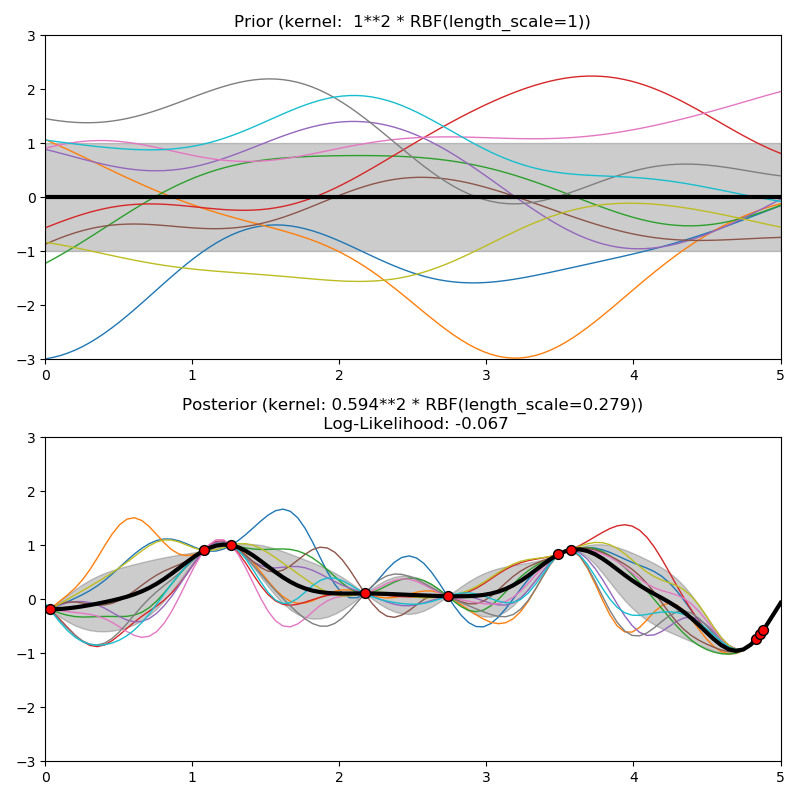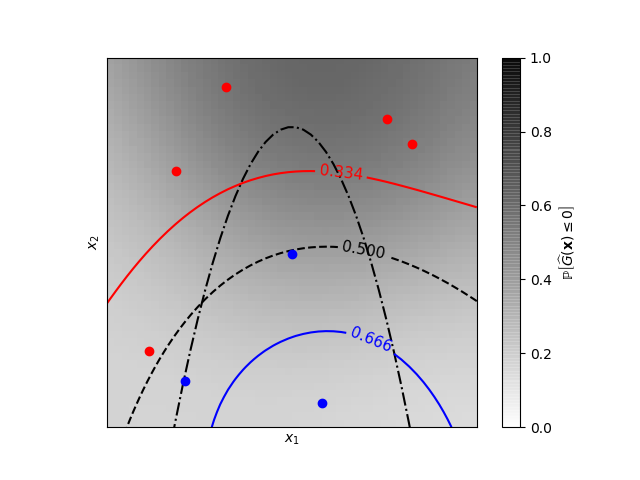sklearn.gaussian_process.ConstantKernel¶
class sklearn.gaussian_process.kernels.ConstantKernel(constant_value=1.0, constant_value_bounds=(1e-05, 100000.0))
恒定的内核。
可以作为乘积核的一部分用于缩放另一个因子(核)的大小,或者作为和核的一部分用于修改高斯过程的均值。
增加一个常数核等于增加一个常数:
kernel = RBF() + ConstantKernel(constant_value=2)
等于:
kernel = RBF() + 2
在用户指南中阅读更多内容。
新版本0.18。
| 参数 | 说明 |
|---|---|
| constant_value | float, default=1.0 定义协方差的常量:k(x_1, x_2) = constant value |
| constant_value_bounds | pair of floats >= 0 or “fixed”, default=(1e-5, 1e5) 常量值的下界和上界。如果将常量值设置为“fixed”,则在超参数调优期间无法更改常量值。 |
| 属性 | 说明 |
|---|---|
bounds |
返回的对数变换界限。 |
hyperparameter_constant_value |
|
hyperparameters |
返回所有超参数规范的列表。 |
n_dims |
返回内核的非固定超参数的数量。 |
requires_vector_input |
返回内核是否定义在离散结构上。 |
theta |
返回(扁平的、对数转换的)非固定超参数。 |
示例
>>> from sklearn.datasets import make_friedman2
>>> from sklearn.gaussian_process import GaussianProcessRegressor
>>> from sklearn.gaussian_process.kernels import RBF, ConstantKernel
>>> X, y = make_friedman2(n_samples=500, noise=0, random_state=0)
>>> kernel = RBF() + ConstantKernel(constant_value=2)
>>> gpr = GaussianProcessRegressor(kernel=kernel, alpha=5,
... random_state=0).fit(X, y)
>>> gpr.score(X, y)
0.3696...
>>> gpr.predict(X[:1,:], return_std=True)
(array([606.1...]), array([0.24...]))
方法
| 方法 | 说明 |
|---|---|
__call__(self, X[, Y, eval_gradient]) |
返回核函数k(X, Y)和它的梯度 |
clone_with_theta(self, theta) |
返回带有给定超参数theta的self的克隆。 |
diag(self, X) |
返回核函数k(X, X)的对角线。 |
get_params(self[, deep]) |
获取这个内核的参数。 |
is_stationary(self) |
返回内核是否静止。 |
set_params(self, **params) |
设置这个内核的参数。 |
__init__(self, constant_value=1.0, constant_value_bounds=(1e-05, 100000.0))
初始化self. 请参阅help(type(self))以获得准确的说明 。
__call__(self, X, Y=None, eval_gradient=False)
返回核函数k(X, Y)和它的梯度。
| 参数 | 说明 |
|---|---|
| X | array-like of shape (n_samples_X, n_features) or list of object 返回核函数k(X, Y)的左参数 |
| Y | array-like of shape (n_samples_X, n_features) or list of object, default=None 返回的核函数k(X, Y)的正确参数。如果没有,则计算k(X, X)。 |
| eval_gradient | bool, default=False 确定关于核超参数的梯度是否确定。只有当Y没有的时候才被支持。 |
| 返回值 | 说明 |
|---|---|
| K | ndarray of shape (n_samples_X, n_samples_Y) 内核k (X, Y) |
| K_gradient | ndarray of shape (n_samples_X, n_samples_X, n_dims), optional 核函数k(X, X)关于核函数超参数的梯度。只有当eval_gradient为真时才返回。 |
property bounds
返回的对数变换界限。
| 返回值 | 说明 |
|---|---|
| bounds | ndarray of shape (n_dims, 2) 核函数超参数的对数变换界限 |
clone_with_theta(self, theta)
返回带有给定超参数theta的self的克隆。
| 返回值 | 说明 |
|---|---|
| theta | ndarray of shape (n_dims,) 的hyperparameters |
diag(self, X)
返回核函数k(X, X)的对角线。
该方法的结果与np.diag(self(X))相同;但是,由于只计算对角,因此可以更有效地计算它。
| 参数 | 说明 |
|---|---|
| X | array-like of shape (n_samples_X, n_features) or list of object 参数指向内核。 |
| 返回值 | 说明 |
|---|---|
| K_diag | ndarray of shape (n_samples_X,) 核k(X, X)的对角线 |
get_params(self, deep=True)
获取这个内核的参数。
| 参数 | 说明 |
|---|---|
| deep | bool, default=True 如果为真,将返回此估计器的参数以及包含的作为估计器的子对象。 |
| 返回值 | 说明 |
|---|---|
| params | dict 参数名称映射到它们的值。 |
property hyperparameters
返回所有超参数规范的列表。
is_stationary(self)
返回内核是否静止。
property n_dims
返回内核的非固定超参数的数量。
property requires_vector_input
核是否只对固定长度的特征向量有效。
set_params(self, **params)
设置这个内核的参数。
该方法适用于简单内核和嵌套内核。后者具有形式为
| 返回值 | 说明 |
|---|---|
| self | - |
property theta
返回(扁平的、对数转换的)非固定超参数。
注意,theta通常是内核超参数的对数变换值,因为这种搜索空间的表示更适合超参数搜索,因为像长度尺度这样的超参数自然存在于对数尺度上。
| 返回值 | 说明 |
|---|---|
| theta | ndarray of shape (n_dims,) 核函数的非固定、对数变换超参数 |







